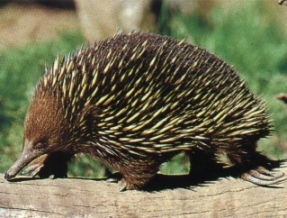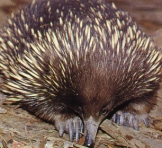ECHIDNA

The Short-beaked Echidna, like the Platypus, is a monotreme, whose young is hatched from an egg. Found all over Australia, the Short-beaked echidna is covered with sharp spines and has strong legs and claws. When threatened, the echidna either rolls into a spiky ball or digs down into the ground.
The Echidna feeds on ants and termites and its mouth and nostrils are on the end of a long, sensitive snout kept moist with mucus. It opens up termite or ant nests with claws and snout, pokes in its saliva covered tongue and flicks insects back into its mouth.
Echidnas mate between
June and September. Up to 8 males may form a "train" which follows a
female around for up to 4 weeks. The males push and shove each other
and the male who is the most persistent eventually breeds with the female.
Mating takes place belly to belly, which avoids the male spiking himself
on the female's spines. About 14 days after mating, the female lays
a leathery-shelled egg, which is incubated in her pouch for about 10
days before hatching into a baby that sucks milk from a patch on its
mother's belly. The tiny baby cannot store iron in its body and the
large amount of hemoglobin in the mother's milk colours the fluid pink.
The milk is very weak when the baby first suckles, but by the time it
is weaned the milk is nearly 50% solids. The young stays in the pouch
until its spikes develop, then it is left in a nursery burrow. The mother
returns to suckle the baby every 5 to 10 days and the young echidna
takes in around 20% of its body weight in milk at each feed. It is very
vulnerable to predators during this stage of its life. The young Echidna
leaves the burrow between 6 and 8 weeks after hatching.

DID YOU KNOW?
- An Echidna's spines, skin and fat that lie underneath may make up one-third of its body weight.
- If a burrowing Echidna is touched, it will hunch its shoulders, bristling up all its spines.
- An Echidna has no teeth. It crushes its insect food between horny plates on its tongue and the roof of its mouth.
- An area on the tip of an Echidna's snout is sensitive to electric signals given out by the bodies of insects.
- An Echidna's intelligence is about the same as that of a rat. It is slightly less intelligent than a cat.
- An Echidna can lift objects twice its own weight.
- Echidnas can swim
| BACK TO MAMMALS |
| mammals | | | birds | | | reptiles | | | spiders |